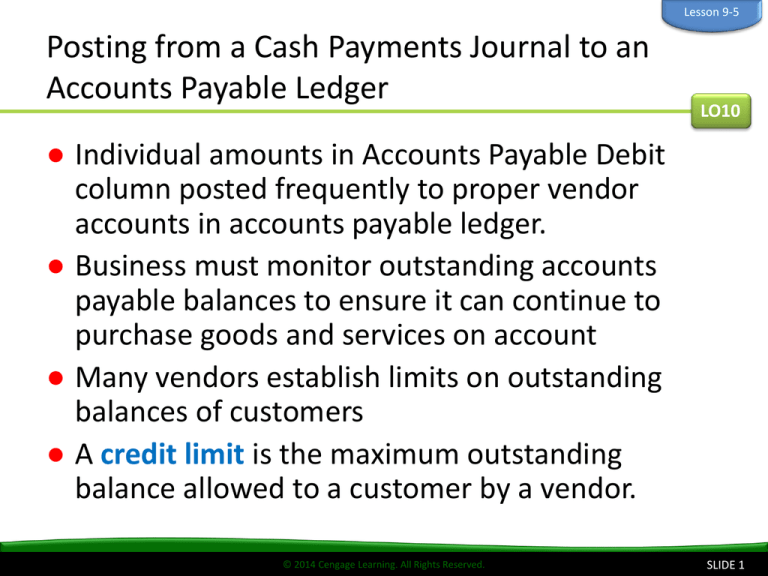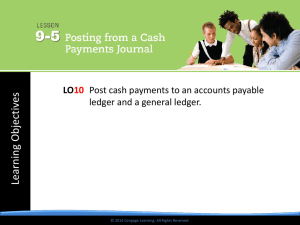
Lesson 9-5
Posting from a Cash Payments Journal to an
Accounts Payable Ledger
LO10
● Individual amounts in Accounts Payable Debit
column posted frequently to proper vendor
accounts in accounts payable ledger.
● Business must monitor outstanding accounts
payable balances to ensure it can continue to
purchase goods and services on account
● Many vendors establish limits on outstanding
balances of customers
● A credit limit is the maximum outstanding
balance allowed to a customer by a vendor.
© 2014 Cengage Learning. All Rights Reserved.
SLIDE 1
Lesson 9-5
Posting from a Cash Payments Journal to an
Accounts Payable Ledger
LO10
Journal Page Number 2
Date
3
1
Debit
5 Vendor Number
4
Account Balance
© 2014 Cengage Learning. All Rights Reserved.
SLIDE 2
Posting from the General Amount Columns of
a Cash Payments Journal to a General Ledger
● Each amount in General columns of cash
payments journal posted individually to
general ledger account written in Account
Title column
© 2014 Cengage Learning. All Rights Reserved.
SLIDE 3
Lesson 9-5
Posting from the General Amount Columns of
a Cash Payments Journal to a General Ledger
LO10
Journal Page Number 2
Date 1
3 Debit
5 Vendor Number
4
Account Balance
© 2014 Cengage Learning. All Rights Reserved.
SLIDE 4
Informal Writing
● Summarize the process for posting from the
cash payments journal to the subsidiary and
general ledgers in three bullet points
© 2014 Cengage Learning. All Rights Reserved.
SLIDE 5
Totaling, Proving, and Ruling a Cash Payments
Journal
● Journal proved and ruled whenever journal
page is filled and always at end of month
● Total for each column written in next available
line
● Totals used to prove debits equal credits
● Common errors include entering amounts
incorrectly and entering correct amount in
wrong column or even wrong journal
© 2014 Cengage Learning. All Rights Reserved.
SLIDE 6
Lesson 9-5
Totaling, Proving, and Ruling a Cash Payments
Journal
1 Date
3
2 “Totals”
Single Rule
5
4
© 2014 Cengage Learning. All Rights Reserved.
LO10
Double Rule
Column Total
SLIDE 7
Posting from the Special Amount Columns of
a Cash Payments Journal to a General Ledger
● Total of each special amount column…posted
to account names in column’s heading…
whenever page is filled and at end of month
● Totals of General amount columns not posted
● Each amount in these columns posted individually
to general ledger account
● To indicate these totals are not posted, check
mark placed in parentheses below each column
total
© 2014 Cengage Learning. All Rights Reserved.
SLIDE 8
Lesson 9-5
Posting from the Special Amount Columns of
a Cash Payments Journal to a General Ledger
Journal Page 2
Number
Date 1
Debit or Credit Amount
3
LO10
5 Account Number
4
Account Balance
5
1
2
3
4
1
© 2014 Cengage Learning. All Rights Reserved.
2
5
3
4
SLIDE 9
Lesson 9-5
Completed Accounts Payable Ledger
© 2014 Cengage Learning. All Rights Reserved.
LO10
SLIDE 10
Lesson 9-5
Proving the Accounts Payable Ledger
LO10
● Controlling account balance in general
ledger…must equal sum of all account
balances in subsidiary ledger
● A listing of vendor accounts, account balances,
and the total amount due to all vendors is
called a schedule of accounts payable.
● Also known as an account payable trial balance
● Schedule of accounts payable is prepared after all
entries in all journals are posted
© 2014 Cengage Learning. All Rights Reserved.
SLIDE 11
Lesson 9-5
Proving the Accounts Payable Ledger
© 2014 Cengage Learning. All Rights Reserved.
LO10
SLIDE 12
Lesson 9-5
Lesson 9-5 Audit Your Understanding
1. In which column of the cash payments
journal are the amounts that are posted
individually to the accounts payable ledger?
ANSWER
Accounts Payable Debit
© 2014 Cengage Learning. All Rights Reserved.
SLIDE 13
Lesson 9-5
Lesson 9-5 Audit Your Understanding
2. List the five steps for ruling a cash payments
journal at the end of the month.
ANSWER
1. Rule a single line across all amount columns.
2. Write the date in the Date column.
3. Write Totals in the Account Title column.
4. Write each column total below the single line.
5. Rule a double line across all amount columns.
© 2014 Cengage Learning. All Rights Reserved.
SLIDE 14
Lesson 9-5
Lesson 9-5 Audit Your Understanding
3. What is the relationship between a
controlling account and a subsidiary ledger?
ANSWER
A controlling account balance in a general
ledger must equal the sum of all account
balances in a subsidiary ledger.
© 2014 Cengage Learning. All Rights Reserved.
SLIDE 15
Numbered Heads Together
● Numbered Heads Together:
● Work in teams of five to complete 9-5 Work Together
● If everyone receives 100% and your team completes it
faster than the other team, your group will receive air
heads
● Not only do you need to receive 100% across the
entire team, but you also need to make sure each
team member can explain the process of posting from
the sales journal to either the General Ledger or
Subsidiary Ledger
● Once we are finished, we will follow the same
procedure for 9-5 OYO (10 mins)
© 2014 Cengage Learning. All Rights Reserved.
SLIDE 16
Proper Order
● Place the index cards with different stages of
posting from the cash payments journal in proper
sequence
● First group to finish first wins!
● Flash Card Review Game
● Each student approaches board to flip over a new card
● If answered correctly, student gets 5 points
● If not, receive nothing
● Students with most points get Starbursts (Jess needs
to receive her amount)
© 2014 Cengage Learning. All Rights Reserved.
SLIDE 17
Closure
● Are credit limits helpful or more harmful?
Why?
● How can you ensure payment?
© 2014 Cengage Learning. All Rights Reserved.
SLIDE 18





